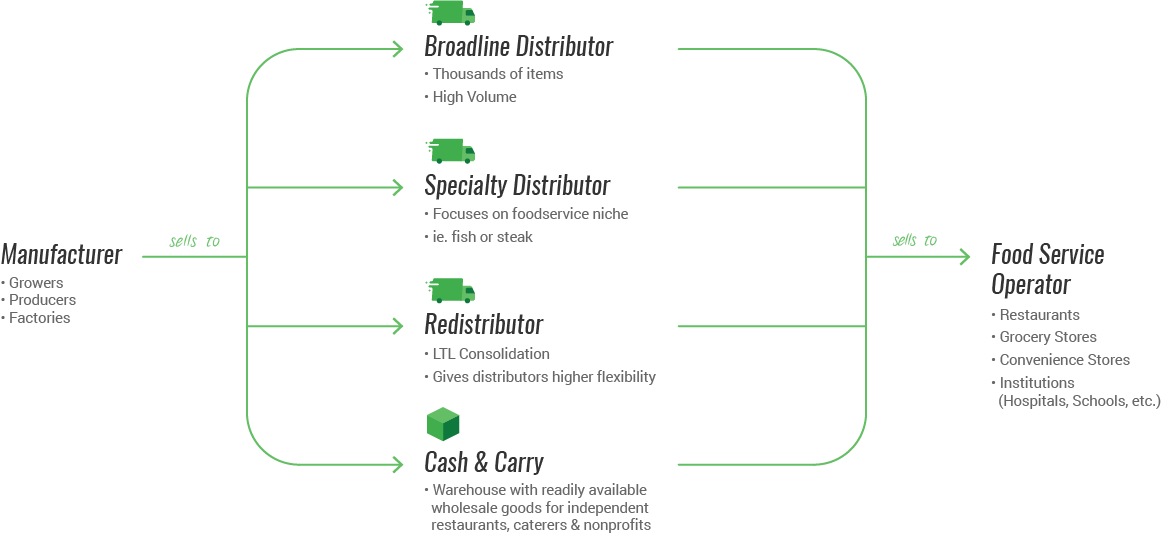Learn about how food distribution works and how it benefits manufacturers, food service operators, and ultimately, the end user.
Food distribution is not as simple as a food service operator calling up a food producer or factory to stock the shelves.
The process benefits significantly from the involvement of a food distributor.
But there are various types of food distributors, and each one comes with unique benefits.
In order to fully understand the foodservice supply chain, it’s essential to understand the role of food distributors and types of distribution companies operating in today’s logistics landscape.
In this post, you’re going to learn about how food distribution works and how it benefits manufacturers, food service operators, and ultimately, the end user.
Let’s get started!
What Does A Food Distributor Do?
A food distributor’s primary function lies in providing food and related items (such as items used to consume food—like cups, plates, napkins etc.) to food service operators.
What’s a food service operator?
A food service operator can be any entity that provides food or related products. A chef at a restaurant, a grocery store, convenience store, school or hospital cafeteria can all qualify as examples.
But food distribution is much more than the simple act of transporting food from a manufacturer to a food service operator.
In fact, some types of foodservice distributors don’t physically deliver goods directly to the food service operator (more on that later).
The Advantages of Commercial Food Distributors
You know what food distributors do and why they’re important, but how do they benefit growers, producers and factories beyond getting products from point A to point B?
Food distributors have multiple roles throughout the process.
Let’s go over a couple of the major functions:
Marketing And Selling
Food distributors are equipped to market and sell the products they carry to food service operators.
In most cases, food service operators purchase foods from distributors because it eliminates the need to go work with individual manufacturers (producers, growers, factories) to procure individual products.
This is not always the case—as evidenced by many farm-to-table restaurants—but it tends to be the most prevalent scenario.
Similarly, the marketing efforts of food distributors allow manufacturers to focus on their core competency and work with distributors as an intermediary, rather than having to manage relationships with individual food service operators.
Many larger distributors have the ability to provide marketing materials along with their merchandise, which can be a huge value add to food service operators.
Transportation And Warehousing
A main function of any distributor lies in transporting products from manufacturers to food service operators.
This allows manufacturers to outsource their logistics without having to manage dedicated fleets and invest heavily in logistics.
Whether warehousing is involved along the way—and what type of warehousing is necessary—depends on the type of distributor and the type of product being distributed.
Many large distributors operate their own warehouses. Some smaller, more specialized distributors may forego warehousing altogether, transporting fresh products in refrigerated sprinters directly from the producer to the food service operator.
It’s also common for small, local distributors to procure LTL shipments from larger distributors, using methods like cross-docking to deliver smaller shipments of products to food service operators.
By the Numbers: The Foodservice Industry
The diverse needs and varied nature of food service operators play a large role in defining the focus of any given food distributor:
- There are currently 1,249,737 food operators in the US alone
- Restaurants make up the biggest chunk, at 648,462, followed by On-site food service (ie. school, hospital, workplace cafeterias; catering; lodging and recreation; military) accounting for 337,150, and Retail foodservice (supermarkets, convenience stores) with 264,125
- The industry is projected to grow in 2018 by .7%
Let’s explore the types of foodservice distributors and how they serve these different groups.
Types Of Foodservice Distributors
There are four primary types of foodservice distributors. Each type tends to cater to specific types of food service operators based on their industry and their needs.

Broadline Distributor
Broadline distributors serve as one-stop-shops for restaurants and retailers in need of purchasing a large number of items.
They are the best solution for buyers seeking an efficient process without needing to use multiple distributors.
Broadline distributors typically don’t specialize in any particular type of product, but they offer thousands of products to serve the needs of food service operators. For this reason, they often work with chains and larger retail outlets, as they have the ability and resources to serve a vast array of clients.
Broadline distributors—based on their size and the volume of goods they provide—offer a variety of advantages to their clients, such as volume discounts, pricing incentives and more dedicated support than that provided by alternative distribution models.
However, broadline distributors aren’t always the best distribution partner for all food service operators:
While broadline distributors offer thousands of products, small operators don’t have much say in influencing the nature of the products the distributor carries or will carry in the future.
Large Leveraged Operators have the ability to negotiate with broadline distributors to bring in new product, but these new products are not always available to all of the distributor’s accounts.
Smaller food service operators can band together to form Group Purchasing Organizations and demand similar terms to Large Leveraged Organizations, but small food service operators don’t have as much flexibility with broadline distributors on their own.
Specialty Distributor
Specialty distributors are pretty much what they sound like:
They specialize in the distribution of one specific product type or industry, and typically set themselves apart through their efficiency in doing so within their niche.
For example:
A specialty distributor for fresh seafood, catering to high class seafood restaurants and seafood markets will design its supply chain and logistics strategy around getting the fresh goods to these food service operators quickly, safely and efficiently.
It will make use of refrigerated fleets and special refrigerated containers, adhering to specific food safety standards. It will also invest in specialty equipment to keep the seafood fresh and safe to eat throughout the process.
All of these factors give this particular specialty distributor a marked advantage over a broadline distributor, which focuses more on a vast array of shelf-stable, packaged goods.
Specialty distributors can also be defined as such if they operate exclusively within a particular industry niche:
Let’s say a specialty distributor works exclusively with Middle Eastern restaurants across a particular region.
Because this distributor only carries limited, niche products, it appeals to chefs at Middle Eastern restaurants, allowing them to choose from a more targeted list of ingredients that may not be available for purchase from a broadline distributor—and potentially eliminating the need to purchase entire pallets of products.
Redistributor
In contrast to broadline and specialty distributors, redistributors do not sell directly to food service operators.
Instead, they still purchase directly from manufacturers, but then work with smaller scale distributors to provide less than truckload (LTL) shipments.
In the food logistics space, not all distributors have the scale or client base to be able to operate solely in bulk quantities. Many of these small distributors serve independent, non-chain food service operators that are too small to work with broadline distributors.
Sticking with the seafood example, a small, local distribution company working with a standalone seafood restaurant could make use of a redistributor to purchase LTL quantities of seafood, using its own refrigerated vehicles to deliver the product to the restaurant.
Cash & Carry
A cash and carry distributor is unique in that it’s the only type of distributor that does not directly transport products to food service operators.
Instead, food service operators go to a cash and carry warehouse and pick out wholesale products to purchase.
The most common customers of cash and carry distributors are restaurants, caterers and nonprofits.
The Food Distribution System: Diverse And Essential
Each type of food distributor provides unique benefits to the food service operator that calls upon its services.
Most importantly, all food distributors help manufacturers and food service operators by serving as an efficient intermediary between production and the end user.
By making use of distributors—producers, manufacturers and food service operators can focus on their core competencies, leaving logistics, transportation, and product marketing in expert hands.
